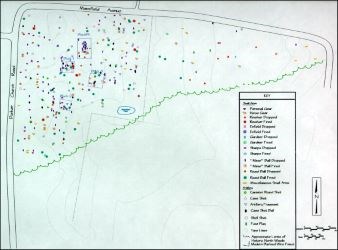Part of a series of articles titled Archeology at Antietam- The Effect of Battle on an Agrarian Landscape.
Article
Battle in the North Woods

NPS
Maps of Artifacts Recovered from the North Woods

NPS
Archeologists from URS Greiner surveyed 25% of the original North Woods area using metal detectors and found 317 military artifacts. The majority of military material consisted of 217 artifacts from small arms, 83 artillery shell fragments, and 17 personal items. An additional 50 objects were recovered, such as horsetack, which may have been used by the military.

NPS
Historic accounts of the battle indicate the North Woods was occupied solely by Union troops, while the Confederates engaged in this portion of the battlefield were located approximately 400 yards to the south at the D. R. Miller farm. Therefore, all fired bullets recovered from the North Woods are attributed to incoming Confederate rounds.
The recovery of fired .69 caliber round ball shot and various conical .36 and .44 caliber pistol bullets from the North Woods raises questions concerning the documented Confederate line of advance into this portion of the battlefield. The effective range of the outdated smoothbore musket which fired the .69 caliber round balls was approximately 100 yards. Pistols, carried primarily by line officers for defensive purposes, had an even shorter range. Did Confederate troops come closer to the North Woods than historical accounts indicate?

NPS
Dropped, or unfired, rounds came from Union troops which were stationed in, or passed through, the North Woods. Specifically, unfired Sharps bullets located in the western portion of the woods along Hagerstown Pike were dropped by members of the 2nd U.S. Sharpshooters or the 9th Pennsylvania Reserves as they marched southward. A concentration of nearly identical .58 caliber, conical "Minié balls" in a seemingly sheltered area of the woods can be attributed to the 19th Indiana Regiment, which was stationed in this portion of the North Woods for several hours.
Union and Confederate Bullets Recovered from North Woods

NPS
Generally, similar types of small arms bullets were used by both sides during the battle. However, based on archeological evidence from the North Woods, the Union soldiers were better supplied with conical, Minié bullets used in rifle muskets like the U.S. "Springfield" and the English Enfield, the most common long arms of the Civil War.

NPS
Confederate bullet supply – based on the North Woods collection – indicates a heavier reliance on the outdated smoothbore muskets which fired .69 caliber round balls. However, the use of rifled long arms is indicated by .58 caliber, conical Minié bullets, like southern-manufactured Gardners, and English-style Pritchetts (used specifically for the Enfield). A high percentage of fired Minié bullets recovered in the North Woods may be of Union manufacture, possibly taken from the Federal stores captured by General Stonewall Jackson's men during their successful attack on the Union garrison at Harpers Ferry, immediately before the Battle of Antietam.
Modified Bullets

NPS

NPS

NPS
Last updated: April 20, 2020
